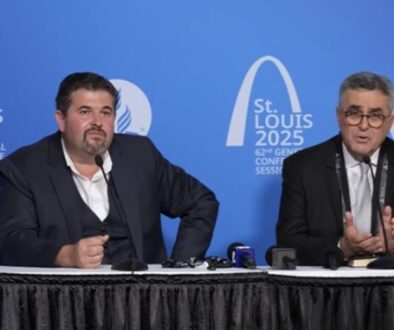Vector Protocols, Working Faith and a New Year
by Monte Sahlin
By Harry Banks, January 1, 2014
Hitchhiking in a foreign country without knowing the language is an adventure.
What's a vector?
First let me tell you a story. In the 1960’s I attend Newbold College in England just west of London, and in the spring decided to catch a ferry across the channel and tour the continent. I arrived in Dunkirk at about 5:30 on a Whitsun holiday morning.
(Whitsun is a European holiday on the seventh Sunday after Easter, celebrating the falling of the Holy Spirit upon the disciples. … for those of you who care…)
Anyway there were huge flags all up and down the main thoroughfare. Not a soul on the streets, just the tap, tap of my own footsteps and the whisper of breeze through the limp flags. No people. No traffic. A holiday! It didn’t look like I had planned very well for a trip depending on the kindness of traveling strangers.
I was armed for this adventure with a small greeting card-sized map of Europe in the back of a diary my aunt had given me, and maybe a five-word French vocabulary. No French money (it was before the Euro) and no French phrase book.
So the problem was how to get to Paris. My in-depth research had at least informed me that the French pronounced Paris as Pa-ree. I walked through town. Still no traffic …
Finally, I found a motorist picking up his early Sunday paper. A short ride for a few blocks. Then the decision where to next? My little map didn’t really have that level of detail.
I pointed left. Pa-ree? No.
I pointed straight ahead? Pa-ree? No.
I pointed right? Pa-ree? A head nod.
Ah! That was all I needed. I jumped out of the car and started down the next road.
That is how vector protocols work.
You get to a location and all you are told is, if you follow that sign post you will eventually get to your desired destination. You don’t know how far. (Sometimes you may get a hint about the number of intersections.) You don’t know how many twists and turns. You don’t know how reliable each route is going to be. All you know is that if you take off in that direction it leads to your destination.
(And for those of you who care, I did make it to Paris that day. But, that’s another story. It really was filled with unexpected adventure.)
Vector faith versus proclamation truth.
Meanwhile back at the intersection: I’ve marveled over the past several years about how little my Adventist heritage of faith seems to facilitate a working faith, a working vector based faith.
Let me explain. It seems we mostly focus on proclaimed truth. Proclaimed truth is not faith. Proclaimed truth is just that, a statement of some fact or belief. It is not character. It is not following a journey when things are less than complete. Proclaimed truth can lull the proclaimer into feeling that they have the complete map. (I had a complete map of all of France; it just lacked detail.) But what do we have to say about how we find the intersection a person is at? What do we have to say about helping that person develop navigational skills to move to the next path?
Would developmental faith be a vector faith?
At my college we invite the community to come for education. Not everyone has a full college-ready set of skills. So, for example, someone with minimal or no math skills shows up, takes a placement test, and is placed in what we call a “Developmental Math” class. That’s where they have a chance to acquire those missing skills and become ready for the challenge of college.
I’m just not seeing the “Developmental Faith” classes in the church. I see “Developmental Indoctrination” classes; but they are devoid of living faith skills, devoid of love, devoid of forgiveness, devoid of resources for long-suffering and patient example-ing (modeling) of a redemptive servant Savior.
This year I have been spending my Sabbaths with a nondenominational In His Steps Community Fellowship which meets Saturday mornings at the phone company for Bible study. We are a group which includes a former atheist, some Baptists, some Methodists, some Pentecostals, some truly nondenominational (and yes we have figured out that even nondenominational people have a “set” of beliefs), and a group of Adventists. We often wonder at some of the strange sets of circumstances which have brought us together. (But that is another story.)
The focus of the group is to take anyone (Did I say “anyone”?) where they are and provide a place of warmth and acceptance while they safely explore their personal experience and figure out where they need to go next.
The Christmas story is full of vectors.
This Christmas season we have been watching and discussing Kyle Idleman’s “The Christmas Experience” DVD series. It seems that the Christmas map was very incomplete for each player. I’m not even sure Joseph and Mary knew their ultimate destination. They seem to only get guidance like “go to Bethlehem,” or “go to Egypt.” Nothing more comprehensive.
And then just to throw another sample into the mix, “Abraham went out an knew not wither he goeth.” Hmm. … It pretty much sounds like “vector” faith to me. All I know is I’m leaving town.
Vectors don't have all the answers.
So what I’ve been puzzling over is this: How do we find our way? How do we find where we really are? And how do we learn the next path?
And the next set of questions: How do we facilitate the growth of faith in each other? How do we practice Christian behavior so well that someone can start to trust God? How do we love someone through the dark night of the soul when they can’t pray? How do we and our spiritual friends make our way through the cloud of unknowing?
And then there is the human/Divine set of questions: Did I start my day too fast? Did I take time to listen for God’s will? Did I ask for strength to carry out his will? Do I talk too much when I do my prayers? Is my spiritual practice for others to see or the private inner life God seems to prefer.
Vectors require a comment to the path.
This Christmas as I have looked at the denominational push-pull leadership struggle, the focus on divisive issues, the failures of morality, the international imprisonments, the Samoan fight over the dateline, I wonder where is the clear indication of God’s action? How does one determine one’s own way? Are these the most critical issues for a self-destructing world. I recently sat down with local and state police, nurses, hospital personnel, assistant district attorney, client advocates, nonprofits and discussed the implementation of a SART team. (Sexual Assault Response team in my community.) I was amazed by the dedication, training, and commitment each of these players had, some for decades; a commitment to healing the devastation of sexual assault. Their commitment took the concrete form of money, time, training, accountability, teamwork.
I know we have some notable centers of outreach, but at the conference and local church level we seem to demonstrate near total apathy to the real challenges of our communities. Is this the way the “remnant” are to respond to their neighbors? Peter at least noticed the cripple at the temple.
So whatever spiritual place you are in where is the next part of your journey? Are you following a map? Whose map? Is it really complete? Where are you headed?
A New Year's Wish
My wish for you in 2014 is that you will find an opportunity to strike out in a new, fresh spiritual adventure with Divine enablement.



